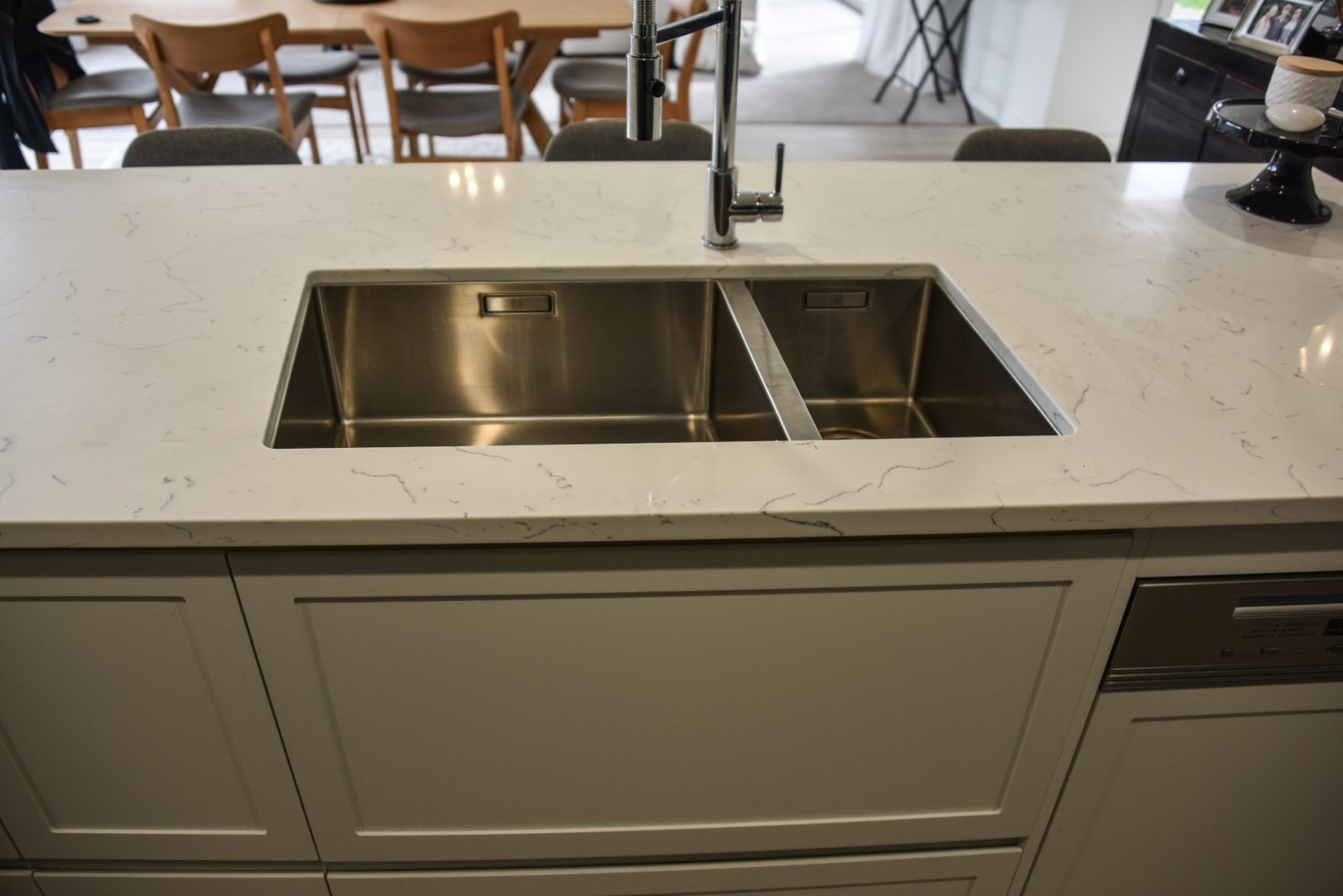Homeowners looking to upgrade their kitchen or bathroom sink have a lot of options when it comes to choosing the right type for their space.
One of the biggest decisions is between an undermount and drop in sink, both of which come with their own set of pros and cons.
To help you make your decision, here are a few key points about the undermount vs drop in sink debate that will give you all the information you need.
Once you’re done with today’s post, feel free to check out this article from Caesarstone if you’d like to learn that types of bathroom sinks work best with quartz countertops.
Undermount vs drop in sink — What’s the difference?
Homeowners who want to upgrade their sink in the kitchen or bathroom have a choice between an undermount and drop in sink.
An undermount sink is mounted underneath the countertop and has no rim, while a drop in sink is put into a hole in the countertop with a rim around it.
Each type of sink has different pros and cons, so it’s important to do your research before making your decision.
Pros and cons of undermount sinks
Undermount sinks have their fair share of pros and cons. These pros include:
- Easy to clean – Because the sink is installed below the countertop, there are no crevices or rims where dirt and grime can build up, making it easier to keep clean.
- Aesthetically pleasing – Undermount sinks provide a more modern look than drop in sinks because they don’t have any visible rims that could interrupt the flow of your kitchen or bathroom design.
- Easier accessibility – When you have an undermount sink installed, it’s much easier for you to slip items into and out of your sink with ease from either side due to its lack of rim around it. This is something that you should keep in mind if you’re on the fence about the undermount sink vs top mount sink debate, as well.
- More space – Without a rim taking up valuable space on your countertop, you can really maximize the workspace in your kitchen or bathroom by installing an undermount sink instead of a drop-in one.
- Homeowners have choices – Homeowners who choose an undermount sink have many choices when it comes to material type (stainless steel, cast iron, etc.) as well as size and shape which makes them ideal for those who want something unique and custom for their home.
The cons of undermount sinks include:
- Expensive installation – Undermount sinks can be expensive to install, as it requires professional assistance due to the complexity of the process compared to installing a drop-in sink.
- Seepage potential – Homeowners should take note that seepage is more likely with undermount sinks because they don’t have rims that act as barriers, so there’s a greater potential for water damage if not sealed properly.
- Not suitable for all countertops – Homeowners need to make sure their chosen countertop is suited for an undermount sink before making any decisions as some materials may not be able to support the extra weight without being damaged or cracked over time.
- Special installation requirements – In order for your undermount sink installation to go smoothly and last longer, homeowners will need special tools like jigsaws and other saws in order to cut out the necessary holes into the countertop material accurately and efficiently.
Pros and cons of drop in sinks
Like undermount sinks, drop in sinks have a number of pros and cons. This is why the drop in vs undermount sink debate is still prevalent.
The pros of drop in sinks include:
- Easier to install – Drop in sinks are easier to install than undermount sinks, as they don’t require any special tools or knowledge of countertop materials.
- Less expensive installation – Since drop in sinks don’t require professional assistance with the installation process like undermount sinks do, homeowners can save money on the overall cost of having them installed.
- Rim acts as barrier against seepage – The rim that surrounds a drop in sink acts as a barrier against potential water damage caused by seepage from above or below the countertop surface.
- More secure fitment – Due to its rim around it, a drop in sink is more securely fitted into place compared to an undermount one which could be prone to shifting over time if not installed properly.
The cons of drop in sinks include:
- Lower water capacity – Homeowners may find that drop in sinks offer less water capacity compared to undermount designs, making them unsuitable for larger dishes or filling large pots with water.
- Poorly sealed edges – Homeowners should be aware that the edges of a drop in sink are not sealed against the countertop and can allow water or food particles to seep underneath and cause damage to the counter materials over time.
- Harder to clean – Homeowners will find it difficult to clean dirt or grime from between the rim of a drop in sink and its countertop due to poor sealing around the edges, which can potentially lead to bacteria growth (if not regularly cleaned properly).
- Limited accessibility – Homeowners should note that accessing items stored beneath a drop in sink is often inconvenient due to limited space when opening cabinet doors below the basin rim, making storage space more limited than with an undermount design.
Undermount vs drop in sink: Pros & cons — Conclusion
Homeowners have a lot to consider when it comes to choosing between an undermount sink or a drop-in one.
Homeowners should weigh both pros and cons when deciding on which style would best suit their needs before making any decisions.
Read more:

